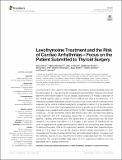Files in this item
Levothyroxine treatment and the risk of cardiac arrhythmias – focus on the patient submitted to thyroid surgery
Item metadata
| dc.contributor.author | Gluvic, Zoran | |
| dc.contributor.author | Obradovic, Milan | |
| dc.contributor.author | Stewart, Alan J. | |
| dc.contributor.author | Essack, Magbubah | |
| dc.contributor.author | Pitt, Samantha J. | |
| dc.contributor.author | Samardzic, Vladimir | |
| dc.contributor.author | Soskic, Sanja | |
| dc.contributor.author | Gojobori, Takashi | |
| dc.contributor.author | Isenovic , Esma R. | |
| dc.date.accessioned | 2021-11-04T09:30:03Z | |
| dc.date.available | 2021-11-04T09:30:03Z | |
| dc.date.issued | 2021-11-04 | |
| dc.identifier | 276241887 | |
| dc.identifier | 497b088e-0542-4081-871a-b8ca2889a446 | |
| dc.identifier | 85119424610 | |
| dc.identifier | 000720308500001 | |
| dc.identifier.citation | Gluvic , Z , Obradovic , M , Stewart , A J , Essack , M , Pitt , S J , Samardzic , V , Soskic , S , Gojobori , T & Isenovic , E R 2021 , ' Levothyroxine treatment and the risk of cardiac arrhythmias – focus on the patient submitted to thyroid surgery ' , Frontiers in Endocrinology , vol. 12 , 758043 . https://doi.org/10.3389/fendo.2021.758043 | en |
| dc.identifier.issn | 1664-2392 | |
| dc.identifier.uri | https://hdl.handle.net/10023/24256 | |
| dc.description | This work is part of a collaboration between the Department of Radiobiology and Molecular Genetics "VINCA" Institute in Nuclear Sciences - National Institute of the Republic of Serbia, Belgrade, Serbia, and Computational Bioscience Reserach Center (CBRC) at King Abdullah University of Science and Technology (KAUST). This work was funded by the MInistry of Education, Science and Technological Development of the Republic of Serbia (Contract No: 451-03-9/2021-14/200017) and KAUST grant OSR No. 4129 (awarded to E.R.I. and V.B.B.), which also supported M.O. M.E. has been supported by the KAUST Office of Sponsored Research (OSR) Award No. FCC/1/1976-17-01, and T.G. by the King Abdullah University of Science and Technology (KAUST) Base Reserach Fund (BAS/1/1059-01-01). | en |
| dc.description.abstract | Levothyroxine (LT4) is used to treat frequently encountered endocrinopathies such as thyroid diseases. It is regularly used in clinical (overt) hypothyroidism cases and subclinical (latent) hypothyroidism cases in the last decade. Suppressive LT4 therapy is also part of the medical regimen used to manage thyroid malignancies after a thyroidectomy. LT4 treatment possesses dual effects: substituting new-onset thyroid hormone deficiency and suppressing the local and distant malignancy spreading in cancer. It is the practice to administer LT4 in less-than-high suppressive doses for growth control of thyroid nodules and goiter, even in patients with preserved thyroid function. Despite its approved safety for clinical use, LT4 can sometimes induce side-effects, more often recorded with patients under treatment with LT4 suppressive doses than in unintentionally LT4-overdosed patients. Cardiac arrhythmias and the deterioration of osteoporosis are the most frequently documented side-effects of LT4 therapy. It also lowers the threshold for the onset or aggravation of cardiac arrhythmias for patients with pre-existing heart diseases. To improve the quality of life in LT4-substituted patients, clinicians often prescribe higher doses of LT4 to reach low normal TSH levels to achieve cellular euthyroidism. In such circumstances, the risk of cardiac arrhythmias, particularly atrial fibrillation, increases, and the combined use of LT4 and triiodothyronine further complicates such risk. This review summarizes the relevant available data related to LT4 suppressive treatment and the associated risk of cardiac arrhythmia. | |
| dc.format.extent | 12 | |
| dc.format.extent | 1555764 | |
| dc.language.iso | eng | |
| dc.relation.ispartof | Frontiers in Endocrinology | en |
| dc.subject | Levothyroxine | en |
| dc.subject | Thyroid | en |
| dc.subject | Hypothyroidism | en |
| dc.subject | Cardiac arrhythmias | en |
| dc.subject | Osteoporosis | en |
| dc.subject | Replacement therapy | en |
| dc.subject | RD Surgery | en |
| dc.subject | RM Therapeutics. Pharmacology | en |
| dc.subject | SDG 3 - Good Health and Well-being | en |
| dc.subject.lcc | RD | en |
| dc.subject.lcc | RM | en |
| dc.title | Levothyroxine treatment and the risk of cardiac arrhythmias – focus on the patient submitted to thyroid surgery | en |
| dc.type | Journal item | en |
| dc.contributor.institution | University of St Andrews. School of Medicine | en |
| dc.contributor.institution | University of St Andrews. Sir James Mackenzie Institute for Early Diagnosis | en |
| dc.contributor.institution | University of St Andrews. Institute of Behavioural and Neural Sciences | en |
| dc.contributor.institution | University of St Andrews. Biomedical Sciences Research Complex | en |
| dc.contributor.institution | University of St Andrews. Cellular Medicine Division | en |
| dc.contributor.institution | University of St Andrews. Centre for Biophotonics | en |
| dc.identifier.doi | https://doi.org/10.3389/fendo.2021.758043 | |
| dc.description.status | Peer reviewed | en |
This item appears in the following Collection(s)
Items in the St Andrews Research Repository are protected by copyright, with all rights reserved, unless otherwise indicated.

